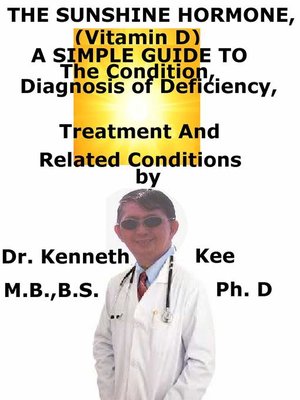The Sunshine Hormone (Vitamin D), a Simple Guide to the Condition, Diagnosis of Deficiency, Treatment and Related Conditions
ebook
By Kenneth Kee

Sign up to save your library
With an OverDrive account, you can save your favorite libraries for at-a-glance information about availability. Find out more about OverDrive accounts.
Find this title in Libby, the library reading app by OverDrive.



Search for a digital library with this title
Title found at these libraries:
| Loading... |
Vitamin D is a fat soluble vitamin hormone which increases the absorption and metabolism of calcium and phosphorous jointly with parathyroid glands.
People who are exposed to normal amounts of sunlight do not require vitamin D supplements because sunlight provides adequate vitamin D synthesis in the skin.
Vitamin D is an active hormone produced by the kidneys that assists to manage the concentration of calcium in the blood and is very important for the formation of strong bones.
Vitamin D is in reality a hormone rather than a vitamin.
The body makes a large amount of the vitamin D it requires; only about 10% comes from the food.
The action of sunlight on the skin manufactures an inert substance called cholecalciferol, which is transformed by the liver to the inert calcidiol in seven days.
Calcidiol is regarded as a good indicator of vitamin D levels and is the form that is normally measured by doctors.
This is later transformed in the kidneys by the enzyme 1α-hydroxylase to calcitriol, a secosteroid hormone that is the active form of vitamin D.
It can also be transformed into 24-hydroxycalcidiol in the kidneys through 24-hydroxylation.
The active form of vitamin D is manufactured primarily by the kidneys, but there are also a number of other tissues in the body that activate vitamin D.
Excess cholecalciferol and calcidiol produced during the summer are stored in the body fat for use during the winter.
Vitamin D alters the action of bone cells and is essential for the development of new bone in children and adults.
It also controls the calcium levels in the blood by helping the body to take in calcium from food and by avoiding calcium loss from the kidneys.
In recent times, the role of vitamin D as a strong controller of other functions throughout the body has been recognized.
There are 5 types of vitamin D: D1, D2, D3, D4, and D5.
The two forms that seem to matter to humans the most are vitamins D2 (ergocalciferol) and D3 (cholecalciferol).
Vitamin D for humans is obtained from
1. Sun exposure,
2. Food especially mushrooms, fish such as tuna, sardines, cod liver oil, eggs, and dairy products.
It is biologically inert and has to go through 2 hydroxylation reactions to become active in the body.
Vitamin D is essential for:
a. Skeletal integrity and the avoidance of:
b. Rickets,
c. Osteomalacia (loss of bone mineralization) and
d. Osteoporosis.
Vitamin D Deficiency is a medical disorder caused by the deficiency of the human of Vitamin D as a result of insufficient dietary intake or impaired absorption.
Insufficient vitamin D from sun exposure or dietary intake results in deficiency states.
Severe vitamin D deficiency has serious results for bone health presenting as rickets in children and osteomalacia in adults.
Vitamin D Deficiency treatment is the avoidance of bone fractures by reducing bone loss and by raising bone density and strength.
The treatment of vitamin D deficiency is with Vitamin D supplements, fortified food and sun light exposure.
The treatment of vitamin D insufficiency can reduce the danger of hip and non-vertebral fractures.
TABLE OF CONTENT
Introduction
Chapter 1 Vitamin D (Calciferol)
Chapter 2 Cause of Deficiency
Chapter 3 Symptoms
Chapter 4 Diagnosis
Chapter 5 Treatment
Chapter 6 Prognosis
Chapter 7 Rickets
Chapter 8 Osteomalacia
Epilogue






